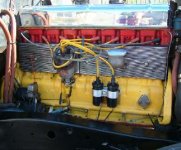Gerry, thanks for the pics! Your oiling system caught my attention. I am wondering if you managed to route 100% of the oil thru the filter, and if yes, how did you modify the main oil gallery to accomplish this?
I remember someone else on this forum had also a full filtered system, but I forgot to ask how he did it. So here's your chance to spill your secrets! Anyone?
I'm also interested to hear if people have kept the Buick "floating" pickup tube functional. In principle it's kind of smart, but I don't know if it might cause the pump to suck air under some conditions?
I remember someone else on this forum had also a full filtered system, but I forgot to ask how he did it. So here's your chance to spill your secrets! Anyone?
I'm also interested to hear if people have kept the Buick "floating" pickup tube functional. In principle it's kind of smart, but I don't know if it might cause the pump to suck air under some conditions?



